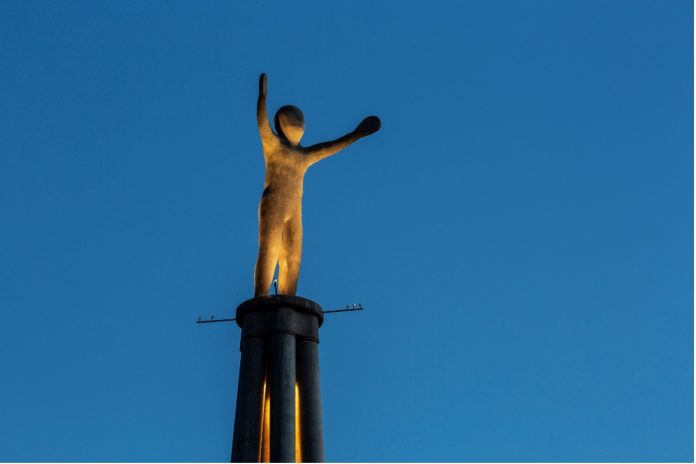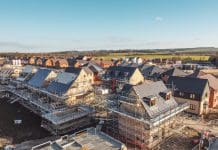Mike Mittendorfer, buildings associate at Ramboll, explores the technical challenges encountered during the creation of the Hope Sculpture cement free, and how collaboration was key to solving these issues
The Hope Sculpture was introduced to the Glasgow skyline as a legacy of the COP26 summit, a symbol of hope for the community and environment, and evidence of what we can achieve when we work together.
The Hope sculpture is over 23m tall and towers over the trees at the edge of woodland in the Cuningar Loop park in Clyde Gateway. It is one of a set of three sculptures designed by Steuart Padwick, based around age, gender, a race-neutral innocent child reaching out for a positive future.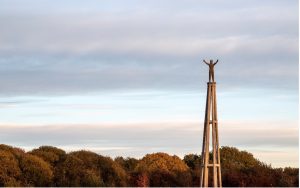
The ground at the Cuningar Loop is quite poor, so Ramboll engineered the Hope Sculpture to be founded on driven recycled tubular steel piles and a reinforced concrete (RC) pile cap. Padwick’s six slender RC columns, arranged in a ring, rise in three tiers to a plinth that supports the statue itself. The ring of columns tapers as it rises, to form an elegant pylon, reminiscent of the brick chimneys that used to pepper the Glasgow landscape.
The base of the Hope Sculpture is finished in black Caithness stone slabs that are engraved with messages of hope from leading Scottish writers, poets and local children. Stone benches complete the area as a space to sit and contemplate.
Beacon uses locally sourced sustainable timber
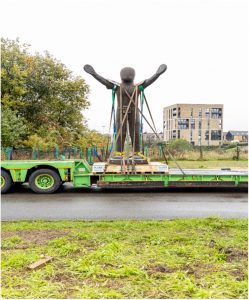 Padwick’s two other pieces are the wooden Beacon of Hope on the concourse of Glasgow Central Station, and the plate steel Hope Triptych within the Rottenrow Gardens in front of Strathclyde University. All 3 pieces address the built environment and how we need to do better if we are to reach net zero.
Padwick’s two other pieces are the wooden Beacon of Hope on the concourse of Glasgow Central Station, and the plate steel Hope Triptych within the Rottenrow Gardens in front of Strathclyde University. All 3 pieces address the built environment and how we need to do better if we are to reach net zero.
It was key to maximise the use of recycled and locally sourced materials so that the sculptures themselves exemplify low-carbon construction. 40% of annual global CO₂ emissions are from the built environment, and of this 11% is due to materials and construction. As the project progressed, it was benchmarked against an equivalent traditional build and by completion and had achieved a remarkable 75% reduction in CO₂.
The Beacon uses locally sourced sustainable timber and the Triptych is cut from recycled plate steel from a local scrapyard. The Hope Sculpture is formed almost entirely in (RC) – one of the construction industry’s greatest challenges when it comes to carbon reduction, mainly due to the high carbon cost of cement. Steuart Padwick and project director Natalie Alexopoulos were relentless in ensuring all materials were recycled, reclaimed or sustainable.
ECOPact Max 100% cement-free concrete
In the early stages of the project, Aggregate Industries offered the use of their ECOPact Max concrete, which is a 100% cement-free product. It had been used previously for piles and foundations, but not for above-ground structures due to limitations on the achievable strength on site.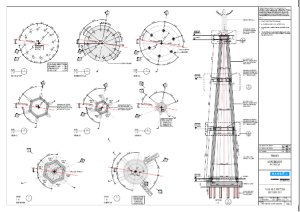
A further offer to supply disused 273 mm diameter oil rig pipes by John Lawrie Tubular, which (owing to their high strength) could be used as piles (designed and installed by LB Civils), and 100% recycled aggregate and steel reinforcement, meant that Ramboll could finalise the substructure to a low carbon design within the parameters of those materials. Contractors, PJ Carey, later constructed the substructure, obtaining the ECOPact Max concrete from a ready-mix batching plant in Duntilland to the east of Glasgow.
The availability of a cement-free concrete mix was an attractive proposition for the superstructure, but we did not have any examples of this being done before. The code for concrete specification, BS 8500, does not cover 100% cement-free concrete, but only goes up to 80% cement replacement. The mix has some interesting properties: it uses an alkali-activated cementitious material that provides early strength gain and enhanced resistance to chemical attack. The high alkali reduces the corrosion rate of embedded steel, so having adopted the recommended cover for an 80% cement replacement is possibly conservative. Low heat of hydration makes it ideal for large pours.
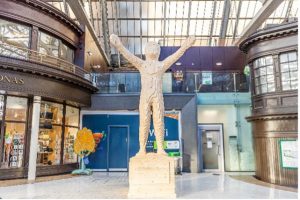 Initially, Padwick worked with Aggregate Industries in developing the mix and finishes. They then conducted trial mixes and pours for the cement-free concrete along with Keltbray, who would later build the superstructure, to test concrete strength, workability, curing times and finish quality.
Initially, Padwick worked with Aggregate Industries in developing the mix and finishes. They then conducted trial mixes and pours for the cement-free concrete along with Keltbray, who would later build the superstructure, to test concrete strength, workability, curing times and finish quality.
Ramboll in turn reviewed the superstructure design to test if a C30/37 concrete would have adequate strength and durability. The trials eventually achieved the required consistency and curing time, with a peak strength of 55kPa. Steuart Padwick approved the finish, so the project was able to proceed with cement-free concrete throughout.
Crushed recycled glass changed the colour of the statue
A further refinement to the Hope sculpture statue (cast by Plean Concrete), which also adopted the cement-free mix, was the introduction of crushed recycled glass in lieu of some of the fine aggregate. This changed the colour of the finished statue and produced a sparkle that reflects the sun during the day and the artificial lighting at night-time.
The Hope Sculpture superstructure and the statue were precast in Keltbray and Plean workshops respectively. This had been envisaged from the outset with the design and connections conceived to facilitate the onsite erection of the various components (columns, middle tiers, plinth, and statue). The statue was cast in six pieces and assembled in the workshop before transportation to site in one piece.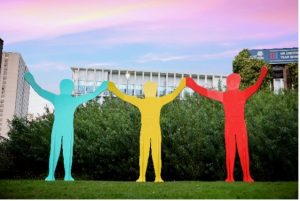
Pre-fabrication provided the quality control needed for the relatively unfamiliar cement-free material and complicated moulds, which may otherwise have led to wasted work and material on site. The moulds themselves remained free of contaminants and damage, facilitating the high-quality finish that Steuart Padwick sought.
A further benefit for this project was that the elements could be cast and checked well in advance of construction, reducing site time and susceptibility of the build to the weather, which can be quite unreliable in Glasgow.
Collaboration was fundamental to the project being delivered on schedule
The collaboration of so many companies was fundamental to the project being delivered on time. The pro bono aspect may in itself have been an influential factor in everyone working together to solve problems quickly, but excellent communication and drive from the project Director, Natalie Alexopoulos, was key.
Early successes in sourcing recycled materials and trials with the cement free concrete were also highly motivating in respect to the low-carbon objective. The sculptures are gifts to Glasgow and South Lanarkshire from a collaboration of over 50 companies all working pro bono.
Each sculpture looks great in its particular setting, and they are all proving to be popular photo opportunities. They all bear messages of hope for the future and act as a showcase to prove what can be done now to reduce carbon in construction.
At Ramboll, the use of cement free concrete has provoked a lot of interest and we are already exploring its use on other projects. Our hope is that the project will spark similar interest and open up new possibilities for the wider built environment sector.



